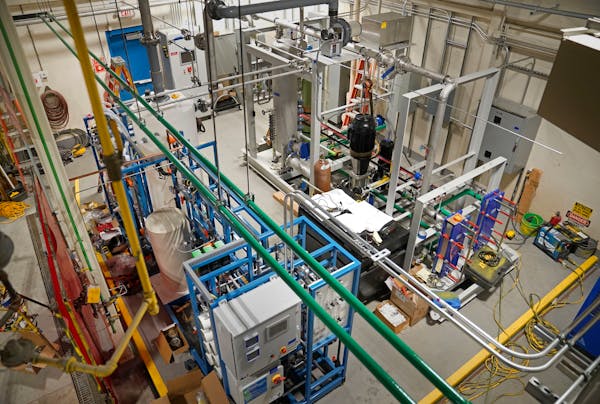Xcel Energy might have to scale back or cancel plans for a major hydrogen production hub in Minnesota if preliminary rules for a federal tax credit don't change.
That stance has put the Minneapolis-based company at odds with some environmental groups who have defended parts of the regulations as critical to avoiding carbon emissions. One major point of contention is whether Xcel could qualify for the credits by tapping into unused wind power and one of its two Minnesota nuclear plants to create carbon-free hydrogen, which are central to company plans.
"This proposal would significantly impair the development of a hydrogen economy," Xcel wrote in a late February letter to the U.S. Treasury Department.
Xcel is a large part of the "Heartland Hydrogen Hub" — which also includes North Dakota, South Dakota, Wisconsin and Montana — one of seven regional hubs selected last year for $7 billion in federal funding from the bipartisan 2021 infrastructure law.
The Upper Midwest group has to negotiate a final plan with the feds but could be in line for as much as $925 million. Xcel said it would spend up to $2 billion on the initiative through a decade.
But Xcel and other Heartland Hub organizers were among a wave of industry voices who said the potential limits on the separate 10-year tax credits from the 2022 Inflation Reduction Act could be a deal breaker because the grant money alone would not be enough to make its hydrogen projects competitive, Xcel said.
Charles Gorecki, CEO of a University of North Dakota environmental center leading the initiative, said in a letter to the Treasury that its rules would "significantly limit, if not outright preclude," the production of hydrogen, forcing partners to re-evaluate their commitment to the Heartland Hub and undermine the purpose of the tax credit.
"As the proposed guidance stands, the scope and benefits of these proposed projects will have to be reevaluated and possibly removed in their entirety," Gorecki wrote.
Objections
The Treasury announced the preliminary rules in December for the "45V" credit and received about 30,000 comments on the guidance. Those rules have largely split industry and environmental groups across the country about what would be the best for the climate while spurring a fuel industry that could slash pollution from parts of the economy seen as more difficult to decarbonize (like gas heating, agriculture and heavy industry).
Xcel estimated hydrogen would cost far too much under the plan, which the company wrote would "slow the development of a hydrogen economy to a crawl."
"Electric generation companies would not voluntarily adopt, system operators would not dispatch and state Public Utilities Commissions would not approve more than a small number of pilot projects at the costs resulting from Treasury's guidance," Xcel said.
Under Treasury guidance, hydrogen produced from carbon-free power sources would receive the 45V credit only if it started running within three years before the hydrogen facility opens.
That guidance would hamper Xcel's hopes of using power from existing wind farms that would otherwise go unused.
That happens when turbines are producing more energy than the electric system can use — wasting the energy — because production is higher than customer energy demand or because transmission lines are so congested they can't deliver the power.
In 2022, the company said it couldn't use 10% of wind power in its Midwest territory, up from 5.1% in 2020. It's one reason behind mega plans for new power lines across the state and region.
Xcel wants to run two nodes for the Heartland Hub, the first of which would create hydrogen with wind from southwestern Minnesota and eastern South Dakota and then sell that hydrogen to a Minnesota ethanol producer. That producer would convert the hydrogen to ammonia and combine it with carbon dioxide captured from ethanol production to make fertilizer for farmers.
The company's second node would tap into wind and solar in Minnesota, as well as nuclear power from its Monticello plant. One potential use is to burn the hydrogen at natural gas plants to replace some of the fossil fuel.
But the Treasury regulations also would rule out Xcel's nuclear plants, which opened in the 1970s and wouldn't qualify for an exception in the policy for nuclear plants that would otherwise retire.
Xcel and the economic development group Greater MSP also said the hydrogen tax credit imperils plans for creating cleaner-burning aviation fuel.
Xcel made a few recommendations. One was to allow 10% of clean electricity from existing sources to qualify for the hydrogen tax credit and allow a higher percentage at times of "sustained" curtailment of renewable power.
The Heartland Hub, which the University of North Dakota's Energy and Environmental Research Center (EERC) leads, has two main corporate partners in Xcel and a joint venture of two fossil fuel companies: Ohio-based Marathon Petroleum and the Canadian pipeline operator TC Energy.
TC Energy and Marathon proposed a North Dakota plant to produce hydrogen from natural gas while aiming to capture and store carbon emissions.
Environmental concerns
Many environmental organizations support the Treasury guidance on using existing power, arguing, in part, using power sources already on the grid to make hydrogen would actually drive up carbon emissions around the country. The Sierra Club and Earthjustice argue when energy companies detail carbon-free power to produce hydrogen, it could drive a need for fossil fuels to fill in the gap for electricity.
The Sierra Club and Earth Justice cast doubt on the idea that nuclear plants around the country are ready to close but for the hydrogen tax credit, though Xcel is hoping to extend the life of its plants to keep using the carbon-free power.
In a joint letter to Treasury, the two organizations said power companies would likely use that 10% exemption at times when renewable power was not going unused.
"In these conditions, renewable energy diverted for hydrogen production would be replaced by dirty, carbon- and pollution-intensive energy sources," the letter read.
When it comes to nuclear, Xcel contended it could divert electricity to hydrogen production when there is abundant renewable power on the grid.

Family of paralyzed teen sues Mayo over back surgery

Troubled chain of SeaQuest aquariums wants bankruptcy judge to approve $80,000 sale

Ramstad: Walz tries to slow runaway spending, moving to political middle

